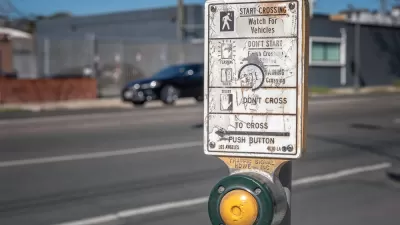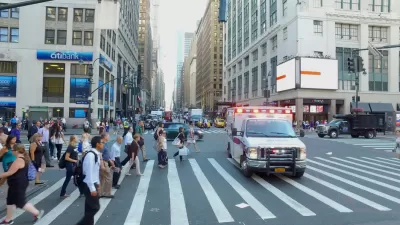With more driving comes a lot more deaths on the nation's roads. The question is why traffic deaths increase at a greater rate than vehicle miles traveled.
Joe Cortright analyses new data from the National Highway Traffic Safety Administration (NHTSA) showing "traffic related deaths are up 11.3 percent for the first nine months of 2015, as compared to the same period a year earlier."
Describing those findings as an "ominous trend," Cortright is willing to go further than the NHTSA in identifying a culprit for the increasing numbers of fatalities on the nation's roadways: the recent increase in driving.
What’s striking about the new NHTSA numbers is that road crash deaths are increasing much faster than total miles driven. As a result, the number of deaths per mile driven—which has been declining for decades—jumped up in the first three quarters of 2015, from 1.05 deaths per 100 million miles to 1.10 deaths per 100 million miles.
Cortright notes that the relationship between vehicle miles traveled (VMT) and driving deaths isn't new. In fact, " the same kind of disproportionate change occurred when gas prices increased in 2007-08. At that time, miles driven fell sharply—and traffic deaths fell even faster. In 2008, total vehicle miles traveled declined by 0.7% and in 2009, they declined a further 1.5 percent."
Cortright isn't alone in analyzing these trends, searching for the reasons why the relationship between traffic deaths and VMT is non-linear. Angie Schmitt reported on the same statistics for Streetsblog USA, sharing the theory of David Levinson about why deaths increase so much when VMT increases: "when gas prices fall, collisions rise faster than mileage because people who don’t ordinarily drive much, like teenagers, start driving more." Cortright also mentions research that shows high fuel prices inspire some motorists to slow down, thus reducing the number of fatal collisions.
FULL STORY: More driving means more dying

Planetizen Federal Action Tracker
A weekly monitor of how Trump’s orders and actions are impacting planners and planning in America.

San Francisco's School District Spent $105M To Build Affordable Housing for Teachers — And That's Just the Beginning
SFUSD joins a growing list of school districts using their land holdings to address housing affordability challenges faced by their own employees.

The Tiny, Adorable $7,000 Car Turning Japan Onto EVs
The single seat Mibot charges from a regular plug as quickly as an iPad, and is about half the price of an average EV.

Seattle's Plan for Adopting Driverless Cars
Equity, safety, accessibility and affordability are front of mind as the city prepares for robotaxis and other autonomous vehicles.

As Trump Phases Out FEMA, Is It Time to Flee the Floodplains?
With less federal funding available for disaster relief efforts, the need to relocate at-risk communities is more urgent than ever.

With Protected Lanes, 460% More People Commute by Bike
For those needing more ammo, more data proving what we already knew is here.
Urban Design for Planners 1: Software Tools
This six-course series explores essential urban design concepts using open source software and equips planners with the tools they need to participate fully in the urban design process.
Planning for Universal Design
Learn the tools for implementing Universal Design in planning regulations.
Smith Gee Studio
City of Charlotte
City of Camden Redevelopment Agency
City of Astoria
Transportation Research & Education Center (TREC) at Portland State University
US High Speed Rail Association
City of Camden Redevelopment Agency
Municipality of Princeton (NJ)





























